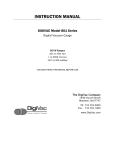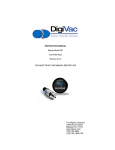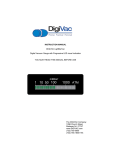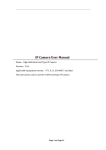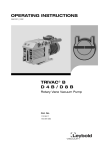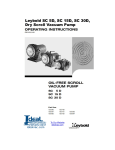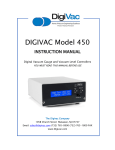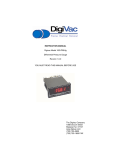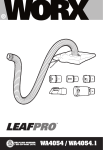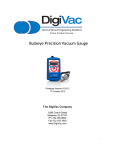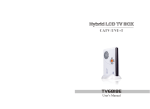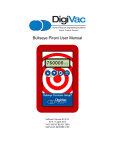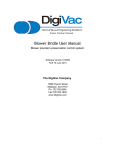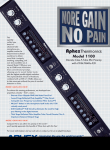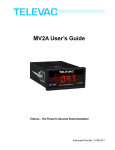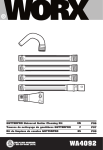Download INSTRUCTION MANUAL DIGIVAC Model 201 Digital Vacuum
Transcript
INSTRUCTION MANUAL DIGIVAC Model 201 Digital Vacuum Gauge and Vacuum Level Controller Revsion K11I14 (HW 11/11) YOU MUST READ THIS MANUAL BEFORE USE The DIGIVAC Company 105B Church Street Matawan NJ 07747 www.DIGIVAC.com (732) 765-0900 (732) 765-1800 FAX CONTENTS 1.0 Description and Principle of Operation. 2.0 Construction. 3.0 Unpacking and Inspection. 4.0 Installation. 5.0 Operation. 6.0 Servicing and Calibration. 7.0 Notes on Calibration. 8.0 Understanding Microns, Torr, and Absolute Pressure. 9.0 Accessories and Modifications 10.0 Attachments and Illustrations. 11.0 Terms & Conditions Instruct/201.4vlc DIGIVAC 201 series Instruction Manual Page 2 1.0 DESCRIPTION AND PRINCIPLE OF OPERATION. The DIGIVAC Model 201 series is a highly configurable digital vacuum control instrument capable of driving and combining multiple sensors. This device can save space, money and complexity by combining many tasks into one device while enabling the user to have any level of accuracy desired for different ranges. It is a highly configurable gauge that accepts different inputs based on driver board and sensor election, and can have different outputs including Analog Recorder, RS232, Ethernet, SPDT relays and VLC outputs. The 201 is configured with sensors based on the accuracy and range required to sense vacuum and display the pressure reading in user selectable units of Torr, mBar or kilopascal. The DIGIVAC Model 201 can either be panel mounted or sit on a bench top, and can use thermocouple, capacitance manometer, PCG750, CDG500, or PVG500 sensors. If in doubt about what gauge sensor you have, consult the DIGIVAC packing list that came with your instrument for positive identification. Consult the DIGIVAC website www.DIGIVAC.com for information about other DIGIVAC vacuum controllers and gauges. The DIGIVAC Model configured with a Varian 531 Thermocouple gauge tube senses vacuum by measuring the temperature rise of an electrically heated thermocouple exposed to a vacuum. As vacuum increases, or, more correctly, as absolute pressure decreases, fewer and fewer molecules of gas are available to cool the thermocouple. With fewer molecules the air temperature rises and the thermocouple gauge thus senses the vacuum. A precision reference inside the DIGIVAC in conjunction with an integrated circuit amplifier controls the electrical excitation of the sensor filament The DIGIVAC Model 201 configured with a capacitance manometer or other active gauge displays the vacuum level that corresponds to the sensor voltage output. The DigiVac Model 201 has a total of 4 slots that can be populated by expansion boards. Types of expansion boards Expansion CM TC 2C VLC Eth Max Number Description 3 Expansion board for use with a capacitance manometer or any supported active gauge 3 Expansion board for use with a Varian 531 Thermocouple guage tube 2 Expansion board with 2 SPDT relay outputs (each output has Common, NC and NO) 1 Expansion board for use to enable upstream vacuum level control 1 Expansion board to enable Ethernet connectivity and web management Types of Sensors supported Expansion Sensor CM Total of 1, 2 or 3 Setra Capacitance manometer, MKS capacitance manometer, PCG 750, PVG500 or CDG 500 TC Total of 1, 2 or 3 Varian 531 Thermocouple gauge tubes 2.0 CONSTRUCTION. The DIGIVAC consists of the indicating and controlling instrument, the sensor configured, the sensor cable, the output interfaces and an international AC power adapter. The instrument is housed in a rugged free-standing plastic enclosure. It can either be placed on a suitable surface, or can be mounted in a 1/8 DIN panel cutout. The gauge tube houses the various thermocouple sensing, heating and compensating elements and terminates in an octal connector. On this model, the connector wiring terminates at the instrument with a 6 position RJ24. Regulating circuitry in the DIGIVAC provides constant current for gauge tube excitation, and thus compensates for resistance in the probe leads. 3.0 UNPACKING AND INSPECTION. DIGIVAC 201 series Instruction Manual Page 3 After the instrument is received, it should be carefully unpacked and inspected for damage during shipment and for completeness. The package should contain, as a minimum, the instrument, the sensor and cable ordered, an AC power adapter and an instruction manual. In the event of a loss during shipment, a claim should immediately be made to the common carrier or the postal service, as applicable. The DIGIVAC warranty pertains only to the instrument, and does not cover losses in shipping. Each 201 should come with: o 201 User Manual (this document) o Display controller (black box with blue buttons) o Mounting Brackets Feet, connectors o Power supply (Phihong with international adapter) o Sensor driver cards and cables o Configured Sensors o VLC (optional) o A Valve with inside port (closest to body) blocked off o 1” of very thin silicon 1/16” I.D. tubing (to be put on valve) o 2 feet of thin silicon 3/32” I.D. tubing (to be connected to very thin tubing on valve and vessel) o RS232 (optional) o RS232 Port o 5’ RS232 Cable (phono to Female DB9) o Ethernet (optional, includes RS232) o Ethernet Port o Null modem RS232 converter o 2’ Ethernet Cable o Null Modem Ethernet Cable o Configuration CD 4.0 INSTALLATION. The instrument should be located in a clean, dry environment for best results. The unit can be panel mounted with the hardware provided in a 1/8” DIN panel cutout (3.64" x 1.78" [92mm x 45 mm]). Alternatively, the unit can be placed on a desktop by placing the 4 rubber feet included with your gauge on the underside of the unit. The gauge tube cable should be identified by wire tags or markings specific to your environment. Thermocouple gauge tubes must be installed in a thread-down orientation in a clean, dry vacuum system. While threading the gauge tube in to the manifold, the gauge tube cable should be disconnected to avoid damage. In this way, twisting of the cable and the octal socket on the tube is avoided. Care should be exercised to install the tubes in a dry part of the system. Since the instrument works on the principle of temperature rise, the probes will not work if they become filled with a liquid such as vacuum or diffusion pump oil. The gauge tube should be protected against oil and other contaminants by installing it in such a way to protect it. A good practice is to mount the gauge tube in the most vertically distant place from oil and other contaminants as applicable. The gauge tube should be mounted in the most stable pressure region of the vessel to be measured. For example, it would be better to install the gauge tube on a tank rather than on the pipe that is directly connected to a vacuum pump. In the event of contamination, see section 6.0 for gauge tube cleaning instructions. If the gauge is used in a Neon sign processing facility, the following is recommended to protect the gauge from damage from bombarding: • • • The gauge tube should be isolated from the system with a stopcock. The stopcock should be closed when bombarding. There should be at least 2 feet of tubing between the electrode and the DIGIVAC. For best results, the tubing should be metal. In extreme cases, the gauge can be absolutely protected by installing a normally open solenoid valve between the gauge tube and the system. The solenoid valve coil should be in parallel with the bombarding transformer. In this way, the solenoid will be closed and the gauge tube will be positively protected whenever bombarding is done. DIGIVAC 201 series Instruction Manual Page 4 • If a gauge is damaged by bombarding, it can generally be brought back to operating condition by replacing the Op amp which controls the gauge tube current. Consult DIGIVAC. The set point connections are in the back of the unit. There are 2 sets of pins. The top row of pins is for set point 1, and the bottom row of pins is for set point 2. The top 3 pins are in the order: 1. common – The common line of a switch 2. N.C. – Normally closed. This means that above the set point value there is a current path between the common and the N.C. terminal. Put another way the switch is “ON” between these 2 terminals. At the set point value and below (higher vacuum, lower pressure) the connection is open. Put another way, the switch is “OFF” between the common and the N.C. connection at higher vacuum (a lower vacuum reading). 3. N.O. – Normally open. This means that above the set point value there is no current path between the common and N.O. connection. Put another way the switch is “OFF” between these 2 terminals. When the vacuum indication goes below the set point value (higher vacuum, lower pressure) the current path closes. Put another way the switch is “ON” between the N.C. and N.O. connections at absolute vacuum readings below the set point value. Take care in insuring that the wire connections are made fast, and the voltage and current does not exceed 250V or 7A. If you need to control a device that draws more power, consider another relay in between the DIGIVAC output and the device to be controlled The Analog output is located in the center of the back panel, and should be connected to a high impedance input. The output impedance is 1KΩ. The RS232 connection can be made to a PLC or computer via a male DB9 cable connection to the female jack on the DIGIVAC. The DIGIVAC acts as a DCE, so a straight serial connection is appropriate. Please use the supplied 5V AC adapter with your Instrument. This adapter provides clean short protected power to protect and insure accuracy of the internal circuitry. 5.0 OPERATION. After installation, the DIGIVAC is ready for immediate operation. The unit will normally provide accurate readings immediately; when used with a thermocouple gauge however, occasionally a gauge tube will have absorbed material during storage and may require as much as 24 hours of operation before accurate readings are attained. It is recommended that the DIGIVAC be energized continuously during vacuum system operation. In this way, the hot filament will not allow contaminants to condense. DIGIVAC 201 series Instruction Manual Page 5 Only connect and disconnect cables with the power to the unit unplugged. Make all connections to sensors, relay outputs and VLC valves with the power disconnected. NEVER DISCONNECT SENSOR OR OUTPUT WIRES WHILE UNIT IS POWERED UP. In cases where the system has contaminants, as is often the case with metalizing and coating equipment, it is often effective to isolate the gauge tube with a solenoid or manual valve during periods when contamination is most active. The DIGIVAC controller can be easily set to the desired units on the fly: 1. Press the “sel” key three times during normal operation. The currently selected units will blink 2. Press the “” and “” to get to the desired unit. 3. Press “Ent” to complete your selection. The DIGIVAC 201 has 2 set points that can be used to actuate external equipment. These 2 set points can be adjusted from the front of the gauge in your currently selected units. 1. To change SP1: a. Press the “sel” key once to enter in set point 1. The SP1 LED should now blink b. Press the “” and “” to get to the desired set point value. Note the set point units are in millitorr. For example a set point of 1000 is equal to one Torr. c. Press enter to accept the new set point value. Normal run mode will resume. 2. To change SP2: a. Press the “sel” key twice to enter in set point 2. The SP1 LED should now blink b. Press the “” and “” to get to the desired set point value c. Press enter to accept the new set point value. Normal run mode will resume. 3. If you don’t want the set points to actuate or the LEDs to illuminate at all, set the set point for “000”. One of the units LEDs to the right of the LCD will always be lit during normal operation to indicate which pressure range the display is indicating. The Instrument has additional outputs which can be used: • • RS232 – The instrument puts out a standard RS232 serial stream with settings 9600, 8, N, and 1. The unit transmits but does not receive, and displays the current vacuum indication in the current units. Analog out – This output reads from 0 to 5 Volts from a pressure of 1 micron all the way up to 5 Torr. There is a graduation of 1 milliVolt per millitorr. Therefore, 10 milliVolts = 10 millitorr and 4 Volts = 4 Torr. 201 VLC installation instructions DIGIVAC 201 series Instruction Manual Page 6 See above for proper installation of the vacuum gauge sensor. Make sure the tube is installed on the actual vessel, and is not in the pathway of the bleed air. Connect the 2 position plug into the 201VLC 2 position vertical port Make sure that the orifice closest to the wires of the valve remains blocked. If this orifice becomes unblocked the bleed valve will not operate properly. If you require using a gas other than ambient air, attach the backfill gas to the bleed outlet at no more than 1psi above ambient air pressure. Additionally, if you don’t require to bleed back an particular gas, the valve may be piped simply by putting the vessel connection on the end.. Next connect the bleed from vessel tube to a hose barb that accepts 1/16” inner diameter hose – we use a 1/8” barb. Below is a pictorial of the connections of the entire system: DIGIVAC 201 series Instruction Manual Page 7 201 VLC Tuning instructions The 201 can operate as a vacuum level controller when so configured. The solenoid valve is mounted as close to the vessel as appropriate, with the wires for the solenoid valve terminating on pins 1 & 2 of the 2 position VLC connector. Set the VLC set point by setting “S” in the tune menu to the desired vacuum level to be maintained. The 201 has been tested on vessels from 0.2 Liters to 50 Liters with good success. In many cases, you may not need to touch the PID tuning variables. In the event that the control out of the box doesn’t work well, you can change the P, I and D variables to obtain a more desirable result. To get to the PID tuning variables, press the “SEL” button until you get to a screen that says “tune”, then hit “ENT” • The first variable is “S” which is what you would use to adjust the set point for VLC control. • Hit “Sel” to the desired variable, either “P”, “I”, “D”, or “o” • When the desired variable is displayed, Press the “” and “” to get to the desired value • Press “ENT” when completed. Not pressing enter will result in no change of PID value. PID overview: PID control is largely used in industry, and refers to the variables in the control equation “proportional,” “integral,” and “derivative.” For a PID primer, refer to http://en.wikipedia.org/wiki/PID_controller • • • • P is implemented as a proportional gain (not as a proportional band). Larger values of P yield smaller error with less stability. The range is 0.01 to 99.99 with units of %. I is also a gain. Larger values of I will yield faster response with less stability. The range is 0.00 to 99.99 with units resets/minute The D Range is 0.00 to 99.99 with units of minutes. O is a feed forward term, and is especially helpful with smaller vessels. The range is from 0-99, where O=99 is traditional PID without the feed forward effect. Here are the recommended PID tuning steps: 1. To Start DIGIVAC 201 series Instruction Manual Page 8 a. Start with P=0.14, I = 0.08, d=0 S=Set Point (1 Torr default), O=0030 b. Increase “O” in increments of 5 until the vacuum level is maintained at ½ Set Point. c. Increase “P” until oscillations observed at about 10% of average reading (not Set Point.. the reading will likely still be lower than set point) d. Set P=P/2 (half the oscillation value of “P” obtained above) e. Start with I=P/4 (at this point the vacuum level should be approaching the set point) 2. Tuning a. If oscillations are greater then desired, decrease “P” 10-20% at a time b. If Vacuum Level is less than the set point, increase I in increments of 20% until 3. convergence at the set point Rules of thumb a. If the vacuum level is below the desired set point with maximum values of P & I, then increase “O” b. If greater then preferred oscillations are occurring when I>P, try setting I=P c. If greater then preferred oscillations are occurring about a set point and P<1, reduce “O” Below are combinations of pumps, vessel sizes and PID variables that were found to show good control. This might be a good place to start. Hose I.D. 0.5 inch 0.5 inch 0.5 inch 0.5 inch 0.5 inch 0.5 inch 0.5 inch 0.5 inch 0.5 inch 0.5 inch 0.5 inch 0.5 inch 0.5 inch 0.5 inch 0.5 inch 0.5 inch 0.5 inch 0.5 inch 0.5 inch Pump Leybold Trivac Leybold Trivac Leybold Trivac Leybold Trivac Leybold Trivac Leybold Trivac Leybold Trivac Leybold Trivac Leybold Trivac Leybold Trivac Leybold Trivac Leybold Trivac Leybold Trivac Leybold Trivac Leybold Trivac Leybold Trivac Leybold Trivac Leybold Trivac Leybold Trivac CFM 1.59 1.59 1.59 1.59 1.59 1.59 1.59 1.59 1.59 1.59 1.59 1.59 1.59 1.59 1.59 1.59 1.59 1.59 1.59 LPM 45 45 45 45 45 45 45 45 45 45 45 45 45 45 45 45 45 45 45 Torr S 4 5 5 5.44 1 0.5 0.3 0.5 0.8 1 1.2 1.5 2.1 3 5 10 0.1 0.07 0.05 P 0.02 0.06 7 0.06 0.06 0.06 0.06 0.07 0.07 0.07 0.07 0.06 0.2 0.2 0.2 0.2 0.05 0.05 0.05 I 0.02 0.02 0.02 0.02 0.02 0.02 0.02 0.02 0.02 0.02 0.02 0.02 0.2 0.2 0.2 0.2 0.05 0.05 0.05 D 0 0 0 0 0 0 0 0 0 0 0 0 0 0 0 0 0 0 0 O 2 40 55 40 40 40 40 67 67 67 67 20 99 99 99 99 99 99 99 1.5 Gallon 1.5 Gallon 1.5 Gallon 1.5 Gallon 1.5 Gallon 1.5 Gallon 1.5 Gallon 1.5 Gallon 1.5 Gallon 1.5 Gallon 0.5 inch 0.5 inch 0.5 inch 0.5 inch 0.5 inch 0.5 inch 0.5 inch 0.5 inch 0.5 inch 0.5 inch Leybold Trivac Leybold Trivac Leybold Trivac Leybold Trivac Leybold Trivac Leybold Trivac Leybold Trivac Leybold Trivac Leybold Trivac Leybold Trivac 1.59 1.59 1.59 1.59 1.59 1.59 1.59 1.59 1.59 1.59 45 45 45 45 45 45 45 45 45 45 0.5 0.8 1 1 1.2 1.5 0.1 0.2 0.07 0.06 0.08 0.04 0.05 0.06 0.06 0.06 0.05 0.05 0.05 0.05 0.02 0.02 0.05 0.02 0.02 0.02 0.05 0.05 0.05 0.05 0 0 0 0 0 0 0 0 0 0 75 75 99 45 45 45 99 99 99 99 7 Gallon 7 Gallon 7 Gallon 7 Gallon 7 Gallon 7 Gallon 7 Gallon 0 0 0 0 0 0 0 0.5 inch 0.5 inch 0.5 inch 0.5 inch 0.5 inch 0.5 inch 0.5 inch Welch 1405 Welch 1405 Welch 1405 Welch 1405 Welch 1405 Welch 1405 Welch 1405 3.2 3.2 3.2 3.2 3.2 3.2 3.2 60 60 60 60 60 60 60 1 0.5 0.2 0.1 3 5 10 0.06 0.06 0.06 1 0.1 0.1 0.1 0.02 0.02 0.02 2 0.1 0.1 0.1 0 0 0 0 0 0 0 99 99 99 75 99 99 99 11.2 Gallon 11.2 Gallon 11.2 Gallon 11.2 Gallon 0 0 0 0 0.5 inch 0.5 inch 0.5 inch 0.5 inch Welch 1405 Welch 1405 Welch 1405 Welch 1405 3.2 3.2 3.2 3.2 60 60 60 60 1 10 5 1 0.06 0.05 0.05 0.05 0.02 0.05 0.05 0.05 0 0 0 0 99 99 99 99 Product Version Sensor 201VLC K11D13 531 201VLC K11D13 531 201VLC K11D13 531 201VLC K11D13 531 201VLC K11D13 531 201VLC K11D13 531 201VLC K11D13 531 201VLC k11D29 CM/10T 201VLC k11D29 CM/10T 201VLC k11D29 CM/10T 201VLC k11D29 CM/10T 201VLC k11D29 CM/10T 201VLC k11D29 CM/10T 201VLC k11D29 CM/10T 201VLC k11D29 CM/10T 201VLC k11D29 CM/10T 201VLC k11D29 CM/10T 201VLC k11D29 CM/10T 201VLC k11D29 CM/10T Config Vessel Size Ballast Vol. TC2/C-TC 0.245 ml 1.5 Gallon TC2/C-TC 0.5 Gallon 1.5 Gallon TC2/C-TC 1.5 Gallon 1.5 Gallon TC2/C-TC 1.5 Gallon 1.5 Gallon TC2/C-TC 1.5 Gallon 1.5 Gallon TC2/C-TC 1.5 Gallon 1.5 Gallon TC2/C-TC 1.5 Gallon 1.5 Gallon CM 0.5 Gallon 1.5 Gallon CM 0.5 Gallon 1.5 Gallon CM 0.5 Gallon 1.5 Gallon CM 0.5 Gallon 1.5 Gallon CM 0.5 Gallon 1.5 Gallon CM 0.5 Gallon 1.5 Gallon CM 0.5 Gallon 1.5 Gallon CM 0.5 Gallon 1.5 Gallon CM 0.5 Gallon 1.5 Gallon CM 0.5 Gallon 1.5 Gallon CM 0.5 Gallon 1.5 Gallon CM 0.5 Gallon 1.5 Gallon 201VLC 201VLC 201VLC 201VLC 201VLC 201VLC 201VLC 201VLC 201VLC 201VLC k11D29 k11D29 k11D29 k11D29 k11D29 k11D29 k11D29 k11D29 k11D29 k11D29 531 531 531 531 531 531 531 531 531 531 TC2/C-TC TC2/C-TC TC2/C-TC TC2/C-TC TC2/C-TC TC2/C-TC TC2/C-TC TC2/C-TC TC2/C-TC TC2/C-TC 1.5 Gallon 1.5 Gallon 1.5 Gallon 1.5 Gallon 1.5 Gallon 1.5 Gallon 1.5 Gallon 1.5 Gallon 1.5 Gallon 1.5 Gallon 201VLC 201VLC 201VLC 201VLC 201VLC 201VLC 201VLC K11D21 K11D21 K11D21 K11D21 K11D21 K11D21 K11D21 531 531 531 531 531 531 531 TC2/C-TC TC2/C-TC TC2/C-TC TC2/C-TC TC2/C-TC TC2/C-TC TC2/C-TC 201VLC 201VLC 201VLC 201VLC K11D21 K11D21 K11D21 K11D21 531 531 531 531 TC2/C-TC TC2/C-TC TC2/C-TC TC2/C-TC Model 201 RS232/command line command set DIGIVAC 201 series Instruction Manual Page 9 The 201 can be remotely connected via a DB9 RS232 cable by setting your HyperTerminal to 9600 baud, 8, none and 1. The unit can be set at the front panel using the membrane buttons as described above. If you’d prefer to control with RS232, use the command set below: DIGIVAC 201 series Instruction Manual Page 10 MODEL 201 “Cheat Sheet” VAC? Vac1? Vac2? Vac3? Get Get Get Get M? Get mode setting. Returns "M=A" for automatic mode, Returns "M=M" for manual mode. M=A M=M M=D Set mode to automatic. Set mode to manual Set to diagnostic mode T? Get timing setting. This is how frequently we will burp out data in automatic mode, in seconds. T=.25 T=30 T=60 T=600 vacuum vacuum vacuum vacuum Set data Set data Set data Set data Accepted range for T reading. reading of sensor in first slot (ex: slot A) reading of sensor in second slot (ex: slot B) reading of sensor in third slot (ex: slot C) burp rate burp rate burp rate burp rate is .25 to to Four times per second. to twice per minute. to once per minute. to once per 10 minutes. 600 U? Get units setting. Responds appropriately with "U=0", "U=1", or "U=2" U=0 U=1 U=2 Set units to Torr Set units to mBar Set units to kPa P? P=2.35 Get P term Set P term I? I=16.789 Get I term Set I term D? D=8.087 Get D term Set D term O? O=99 Get O term Set O term S? S=.82 Get S term Set S term SP1? SP1=123.456 Get SP1 setting. Set SP1 SP2? SP2=34.506 Get SP2 setting. Set SP2 V? Get the Version, such as K11D13 If you purchased the Ethernet option, please refer to the model 200 Ethernet Addendum for initial setup. Your 201 should be set by default with the IP address 192.168.0.200. Surf over to http://192.168.0.200 DIGIVAC 201 series Instruction Manual Page 11 (or whatever your IP address was set to) and say “yes” to security screens authorizing a DIGIVAC applet to run in your browser. You should see a screen that looks like: Feel free to connect to the IP address:10001 with HyperTerminal, putty or your favorite communication tool to communicate directly with the device. To use the 201 web terminal capability, highlight Display ►Terminal DIGIVAC 201 series Instruction Manual Page 12 And then you should see a terminal window popup that you can execute all the commands in: Press carriage return or enter to submit the query or change the set point. Note that while the web terminal is open, the main 201 screen will not update. If at any time the web terminal or the main 201 applet window becomes unresponsive, close the browser (not just reloading the tab or closing the tab) and reconnect. DIGIVAC 201 series Instruction Manual Page 13 6.0 SERVICING - GAUGE TUBE CLEANING. In many cases, a gauge tube may become fouled with oil or other foreign matter. It is often possible to restore the functionality of contaminated probes with cleaning. If the contaminant is known, the tube should be filled with a fluid that is known to be a solvent to that contaminant. As an example, ether is often effective in removing residues of some oils. Commercial carburetor cleaners are very powerful solvents and are highly effective against some contaminants. After cleaning with solvents, the gauge tube should be completely dried or flushed with a volatile solvent to assure that it is dry prior to re-installing it. If this is not done, contamination of the system may result. 6.1 FACTORY REPAIR AND CALIBRATION. The vacuum gauge assembly is designed to provide years of trouble-free service, and the liberal internal use of plug-in components make it easily repairable. No field servicing of the unit is recommended, other than replacement of the gauge tube, but factory servicing and calibration are available at a nominal cost and turn-around times of 24 hours are typical. 6.2 FIELD CALIBRATION. Each DIGIVAC vacuum gauge controller is calibrated to the particular vacuum gauge sensor that is shipped with the unit. While changing the gauge tube is possible, it will result in a slightly different reading as all gauge tubes are not created equal. Although it is preferable that all calibration be performed at DIGIVAC, field calibration can be accomplished. Before re-calibrating the instrument, it should be ascertained that the instrument is in fact incorrect. In many cases, the problem will be with a tube that is fouled, or a system that is operating improperly. It is recommended that a spare tube be kept on hand and stored in a clean, dry place. Then, in cases of suspect readings, the tube should be changed before proceeding further. If adjustments are to be made for thermocouple vacuum gauges, proceed as follows: A) Remove the Instrument from the panel. B) Remove the front panel cover of the instrument and locate the two calibration potentiometers. The “Zero” potentiometer is to the right as you look at the LED Display, the “ATM” or span adjust is to the left closest to the outside of the board. C) Precalibrate a. Set the device on a table top with the tube plugged in b. Place a voltmeter lead on ground (center pin below display) c. Place the positive voltmeter lead on the lower side of the beige capacitor on the top of the board to the left of the display d. Adjust the Zero POT to read 1.77 Volts e. Place the Positive voltmeter lead in the via that is located on the left side of the board towards the edge f. Adjust the span pot so the voltage is 1.185 Volts D) Operate the vacuum system at the lowest attainable pressure, and allow the system and the gauge tube to stabilize for several minutes. Factory zero setting is done at a pressure of .1 millitorr (.1 micron) or less. E) Adjust the zero setting potentiometer so the unit reads zero. Make sure not to under span. Allow the measurement standard to rise to 1 millitorr and make sure the gauge reading also reads 1 millitorr. (Note the POTS are counter intuitive, clockwise makes the value go down and vice versa, and are very sensitive...) F) Check the operation of the gauge at other pressures. Normally, adjustment of the zero will not be interactive with the readings of the instrument at higher pressures. G) The ATM adjustment is normally not necessary. If necessary, adjust the span with the ATM potentiometer. DIGIVAC 201 series Instruction Manual Page 14 a. For the 201H set the vacuum level to a steady 1980 millitorr, and slowly turn the potentiometer on the right until the DIGIVAC gauge reads 1980 millitorr b. For the 201V, set the vacuum level to Atmosphere (approximately 760 Torr) and slowly turn the potentiometer on the right until the DIGIVAC gauge reads 760 Torr, being careful not to over span. c. If you adjust the span, recheck the zero, then the span, and the zero one last time. 7.0 NOTES ON CALIBRATION. The DIGIVAC is calibrated in nitrogen, which has thermal properties virtually identical to air. If you are using a thermocouple vacuum gauge, other gasses will affect the readings by an amount proportional to the thermal conductivity of the gases. In most cases, the gases present in a vacuum system will be air, nitrogen, or oxygen, and no appreciable errors will occur. Certain other gases, however, have thermal conductivity significantly greater than air and will cause the instrument to read higher than the actual amount of pressure. Examples of such gasses are water vapor, fluorocarbon refrigerants, and acetone. Conversely, other gasses have thermal conductivity significantly lower than air and will cause the instrument to read lower than actual pressure. Examples of such gasses include helium, oxygen and to a lesser extent, CO2. When interpreting readings using gasses other than air, it should be borne in mind that the DIGIVAC reads Torr, which is a measure of absolute pressure - that is the opposite of vacuum. Thus, a lower numerical reading actually is a higher level of vacuum. For more information, refer to section 8.0. Note that isolated transducers like capacitance manometers are independent of gas type. 8.0 UNDERSTANDING TORR. The DIGIVAC and many similar instruments are calibrated in microns or "millitorr." It is appropriate to discuss what microns are and to relate microns to other measures of pressure and vacuum. Microns are not really a measure of vacuum at all, but rather of absolute pressure. It will be recalled that the pressure of the atmosphere is 14.696 or approximately 14.7 pounds per square inch at sea level. This pressure is due to the weight of all of the air in the earth's atmosphere above any particular square inch. This 14.696 psi is equivalent to the pressure produced by a mercury column of approximately 29.92 inches high or .76 meters (about 3/4 of a yard) or 760 millimeters of mercury. Atmospheric pressure varies greatly with altitude. It decreases approximately 1 inch of mercury per thousand feet of altitude. It also varies widely with local weather conditions. (Variations of one half inch in a single day are common.) The word vacuum means pressure lower than atmospheric or "suction," but, in describing negative pressure, the atmosphere is only a satisfactory reference if we are dealing with values of vacuum down to about 27 inches of mercury. Below that, it is much more useful to talk in terms of absolute pressure, starting from absolute zero. The DIGIVAC and all similar instruments do just this. One TORR, a commonly used unit, is an absolute pressure of one millimeter of mercury. A millitorr is equal to one thousandth of a TORR. A MICRON is the same as a millitorr. The full scale reading of a DIGIVAC is 1999 microns and is equivalent to 1.999 TORR of approximately 2/760 of atmospheric pressure. This is less than .1 inches of mercury, and less than .05 PSI. DIGIVAC 201 series Instruction Manual Page 15 9.0 ACCESSORIES AND MODIFICATIONS. The following are offered as accessory equipment or field-installed modifications. Padded shoulder strap Case with Velcro closure- For instruments that will be used in the field, particularly in cryogenic applications, a padded shoulder strap case is available. This case holds a DIGIVAC 100tc battery powered gauge in the optimal reading position. The operator can open the Velcro cover, pull out the gauge tube cable, plug it into the tube on the equipment, and see the reading. It was developed to assist in field service of cryogenic tank farms and vacuum jacketed piping. COMPATIBILITY WITH OTHER GAUGE TUBES. On special order, DIGIVAC Instruments can be provided to use with most other vacuum gauge tubes. AC and DC excitation are available. Gauges have been provided for Hastings, Varian, Thermionics, Veeco, VRC, and Fredericks gauge tubes. DIGIVAC 201 series Instruction Manual Page 16 10.0 Attachments and Illustrations. 201 types of expansion boards possible to populate a total of 4 slots Expansion Max Description CM 3 Expansion board for use with a capacitance manometer or any supported active gauge TC 3 Expansion board for use with a Varian 531 Thermocouple guage tube 2C 2 Expansion board with 2 SPDT relay outputs (each output has Common, NC and NO) VLC 1 Expansion board for use to enable upstream vacuum level control Eth 1 Expansion board to enable Ethernet connectivity and web management Types of Sensors supported Expansion Sensor CM Total of 1, 2 or 3 Setra or MKS capacitance manometers, PCG 750, PVG500 or CDG 500 TC Total of 1, 2 or 3 Varian 531 Thermocouple gauge tubes Sensor combinations Driver Max Description TC2 3 For use with a Varian 531 sensor. If multiple are configured, each slot can be displayed one at a time 1CP 3 For use with a CM sensor. If multiple are configured, each slot can be displayed one at a time 2CP 1 Combination where one value will me displayed based on the combination of a 0.1T and 10T CM, or the combination of a 10T and 1000T CM 3CP 1 Combination where one value will me displayed based on the combination of a 0.1T and 10T, and 1000T CM Slot and Driver combinations Slot name Driver Name TC2 TC2 C0.1 1,2,3 CP C1.0 1CP C10.0 1,2,3 CP C100.0 1CP C1000.0 1,2,3 CP Gauge/Device 531-2 0.1 Torr CM 1.0 Torr CM 10 Torr CM 100 Torr CM 1000 Torr CM F70 F70 Varian FRG-700 F72 F72 Varian FRG-720 P75 P75 Varian PCG-750 PV5 PV5 Varian PVG-500 A29 ETH 2C FET A29 - Alcatel ACC-2009 Ethernet Relays VLC Control DIGIVAC 201 series Instruction Manual Page 17 Below is the typical response of a thermocouple vacuum gauge tube. DIGIVAC gauges which use pressure transducers are linear. MilliTorr 0 5 10 20 25 35 50 75 100 150 200 300 500 750 1000 1500 1900 Millivolts 10 9.57 9.32 8.81 8.54 8.11 7.46 6.63 5.96 5.04 4.38 3.56 2.72 2.24 1.97 1.71 1.59 D ig iv a c 5 0 0 S e rie s G a u g e T u b e s 10 9 8 7 6 5 4 3 2 1 0 0 10 25 50 100 200 P re s s u re , M illito rr DIGIVAC 201 series Instruction Manual Page 18 500 1000 1900 11.0 TERMS AND CONDITIONS . TERMS OF USE, LIMITED WARRANTY & LIABILITY WAIVER THE DIGIVAC COMPANY (“DIGIVAC”) offers all of its products with the following terms and conditions and notices as follows. By accepting and/or using a DIGIVAC product, you hereby acknowledge and agree to the following terms and conditions, and acceptance of these terms and conditions are a condition precedent to any purchase/sale agreement between you and DIGIVAC. EXCLUSIVE OBLIGATION: The DIGIVAC product you are purchasing has been designed for a specific use within a set of suitable operating conditions, as set forth in its User Manual, or as indicated otherwise by DIGIVAC. Any use of the DIGIVAC Product for any purpose or under any conditions, other than those specified, shall render any limited warranty void, and shall expressly invalidate any liability of DIGIVAC for damages as a result of such misuse. USER LIMITATION: You may not modify, copy, distribute, transmit, display, perform, reproduce, publish, license, create derivative works from, transfer, or sell, any information, software, products or services obtained from or created by DIGIVAC to any third party, without the express written consent of DIGIVAC to do otherwise. Any violation of this provision shall give rise to an indemnification of DIGIVAC by you, for any third party claims arising out of such violation. THIRTY (30) DAY LIMITED WARRANTY: All DIGIVAC products are warranted against any manufactured defect for a period of thirty (30) days from date of purchase, unless such product is a custom-work for you and not a standard DIGIVAC product. Any product qualifying as a custom-work shall not be warranted against any defects for any purpose, and your acceptance of such custom-work shall relieve DIGIVAC of any liability for any purpose. WITH THE EXCEPTION OF THE LIMITED WARRRANTY ABOVE, YOU AGREE ANY DIGIVAC PRODUCT IS PROVIDED AS IS, EXCLUSIVE OF ANY WARRANTY, INCLUDING, WITHOUT LIMITATION, ANY IMPLIED WARRANTY OF MERCHANTABILITY, FITNESS FOR A PARTICULAR PURPOSE, NON-INFRINGEMENT, OR ANY OTHER WARRANTY, EXPRESSED OR IMPLIED. LIMITATION OF LIABILITY: You agree and acknowledge, DIGIVAC shall have no liability to you whatsoever for any direct, indirect, punitive, incidental, special consequential damages arising out of or connected with the use or misuse of its products. In particular, given the nature of DIGIVAC products, you agree and acknowledge, under no circumstances whatsoever shall DIGIVAC be liable to you for any consequential damages for damage to any non-DIGIVAC product or service, arising from the failure, use or misuse of a DIGIVAC product, including, but not limited to, any vacuum system, engine, vehicle, factory, or the like. In the event, a court of law with proper jurisdiction finds DIGIVAC liable to you for any purpose, you agree and acknowledge DIGIVAC’s maximum liability shall not exceed the purchase price of one unit of product giving rise to such liability, or $250.00, whichever is greater. ENTIRE OBLIGATION: These terms and conditions express the entire obligation of DIGIVAC with respect to its products. If any part of these terms and conditions are deemed void, invalid, unenforceable or illegal, including, but not limited to, the warranty disclaimers, liability disclaimers and liability limitations set forth above, then the unenforceable clause or sentence may be disregarded with the remainder of these terms and conditions valid and enforced. In the event the unenforceable clause or sentence leaves a void in these terms and conditions, a provision closely matching the intent of the unenforceable provision should be deemed inherent within these terms and conditions, slightly modified to render such provision valid and enforceable. GENERAL: These terms and conditions are governed by the laws of the State of New Jersey, USA. You hereby consent to the exclusive jurisdiction and venue of the Courts of New Jersey, in all disputes arising out of or relating to the use of this product. Use of this product is unauthorized in any jurisdiction that does not give effect to all provisions of these terms and conditions. MODIFICATION OF TERMS AND CONDITIONS: DIGIVAC reserves the right to change the terms, conditions, and notices under which their products are offered. DIGIVAC 201 series Instruction Manual Page 19




















